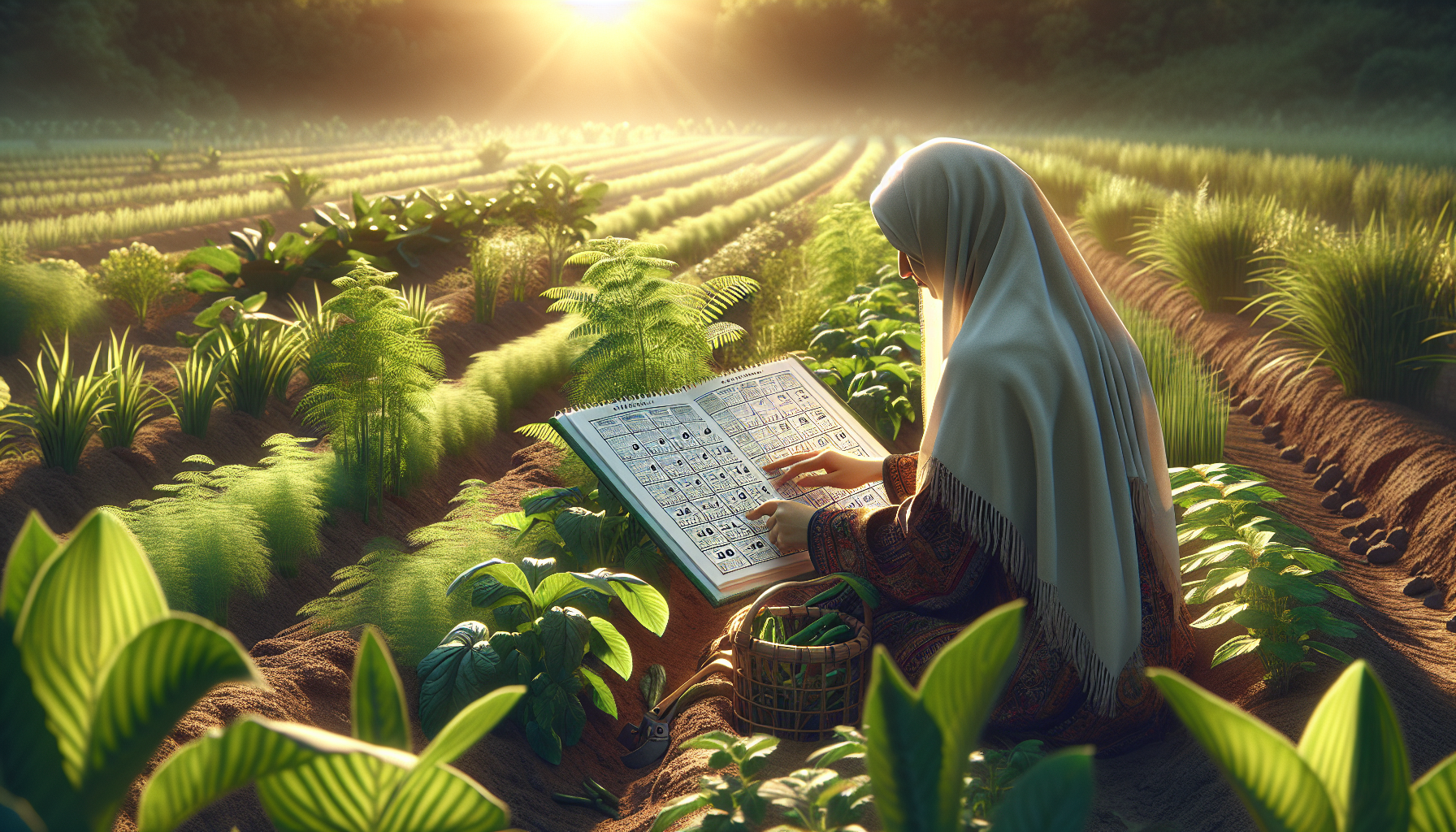In the intricate dance of nature, timing is everything. From the first whisper of spring to the final harvest of autumn, every season presents its own unique challenges and opportunities for farmers and gardeners alike. The art and science of planting, nurturing, and harvesting crops have been honed over centuries, and yet, every new planting season brings its own set of variables and uncertainties. One of the most invaluable tools at the disposal of modern agriculturists is the planting calendar—a guide that not only marks the passage of time but also charts the course for successful cultivation. 🌱
As we embark on a journey through the pages of this article, we delve into the world of planting calendars and their pivotal role in agriculture. These calendars are more than just schedules; they are comprehensive frameworks that help align agricultural practices with the rhythms of nature. At their core, planting calendars are about synchronization—timing the sowing, growing, and harvesting of crops to coincide with the most favorable environmental conditions. This synchronization is crucial for maximizing both the growth potential and the eventual yield of crops, ensuring that every seed sown can reach its fullest potential.
Throughout this article, we will explore several key aspects of planting calendars that are essential for mastering agriculture. We’ll begin by examining the fundamental principles behind these calendars, including the influence of climate zones, soil conditions, and seasonal variations. Understanding these principles is crucial for anyone seeking to optimize their agricultural practices, whether on a small garden plot or a sprawling farm. We’ll also delve into the science behind phenology—the study of cyclic and seasonal natural phenomena—and how it informs planting calendars to create more resilient and productive agricultural systems.
Furthermore, we’ll discuss practical applications and real-world examples of planting calendars in action. From traditional farming methods to cutting-edge technological advancements, we’ll uncover how different approaches to planting calendars can be tailored to meet the specific needs of various crops and regions. As we navigate through these topics, we’ll also address common challenges faced by farmers and gardeners, such as unpredictable weather patterns and climate change, and how adaptive planting calendars can offer solutions. By the end of this comprehensive exploration, you’ll be equipped with the knowledge and tools needed to master agriculture with the strategic use of planting calendars, unlocking the full potential of every seed planted. 🌾
Understanding the Importance of Planting Calendars in Agriculture
Planting calendars are indispensable tools in modern agriculture. They provide a systematic approach to farming by organizing planting schedules according to climatic conditions, crop requirements, and regional specifics. These calendars are not just simple schedules; they are strategic guides that help farmers maximize yield and ensure sustainable agricultural practices. By aligning planting activities with seasonal patterns and environmental factors, farmers can optimize crop growth, improve harvest quality, and reduce waste.
One of the core advantages of using planting calendars is the ability to plan for optimal planting times. These calendars take into account the specific temperature, rainfall, and daylight requirements of different crops. This ensures that seeds are sown under the most favorable conditions, enhancing germination rates and reducing the risk of crop failure. Additionally, planting calendars can help in predicting pest and disease cycles, allowing farmers to implement preventative measures that safeguard crop health.
Furthermore, planting calendars facilitate crop rotation and diversification, which are crucial for maintaining soil health and fertility. By rotating crops according to a planned schedule, farmers can prevent soil depletion and minimize the occurrence of pests and diseases that thrive on specific crops. This leads to a more resilient farming ecosystem and contributes to the long-term sustainability of agricultural lands. The strategic use of planting calendars can also assist in water management, helping farmers conserve this vital resource by aligning irrigation schedules with natural rainfall patterns.
How to Create and Use a Planting Calendar Effectively
Creating a planting calendar involves several steps and requires an understanding of local climate conditions, soil types, and crop varieties. The first step is to gather data on regional weather patterns, including average temperatures, rainfall, and frost dates. This information is crucial in determining the best times to plant and harvest different crops. Farmers can access this data through local agricultural extensions or online resources that provide detailed climatological information.
Once the climate data is collected, the next step is to choose the crops that are best suited for the region. Different crops have specific requirements for temperature, sunlight, and moisture. By selecting the appropriate varieties, farmers can ensure that their crops will thrive in the local conditions. Additionally, it’s important to consider the market demand and crop profitability when selecting which crops to plant.
With the climate data and crop selection in place, farmers can create a planting schedule that outlines the optimal planting and harvesting dates for each crop. This schedule should be flexible enough to accommodate unexpected weather changes or other unforeseen circumstances. To assist in this process, farmers can use software tools or mobile applications designed for creating and managing planting calendars. These tools can provide real-time updates and alerts, helping farmers stay on track and make informed decisions throughout the growing season.
The Role of Technology in Enhancing Planting Calendars
Technology has revolutionized the way planting calendars are created and utilized. With the advent of digital tools and mobile applications, farmers can now access planting calendars on their smartphones or tablets, allowing for real-time updates and adjustments. These technological advancements have made it easier for farmers to manage their schedules and respond quickly to changes in weather or market conditions.
One popular tool is the use of Geographic Information Systems (GIS) in agriculture. GIS technology allows farmers to map their fields and analyze spatial data to create precise planting schedules. By overlaying weather data, soil maps, and crop information, farmers can identify the best planting zones within their fields and optimize resource allocation. This level of precision helps in maximizing yields and minimizing waste, leading to more efficient farming practices.
Another technological innovation is the use of predictive analytics in planting calendars. By analyzing historical data and weather forecasts, predictive models can provide farmers with insights into potential risks and opportunities. For instance, if a forecast predicts a dry spell during the typical planting season, farmers can adjust their schedules to plant drought-resistant crops or implement water-saving measures. This proactive approach helps mitigate risks and enhances the resilience of farming operations.
Comparing Traditional and Modern Planting Calendars
Traditional planting calendars have been used for centuries, often based on generational knowledge and observations of natural cycles. These calendars rely heavily on local wisdom and are tailored to the specific conditions of an area. They are simple and effective, but they may lack the precision and adaptability offered by modern methods.
Modern planting calendars, on the other hand, leverage scientific data and technology to provide a more accurate and flexible approach to planting. By integrating data from various sources, such as weather stations, satellite imagery, and soil sensors, modern calendars offer a comprehensive view of the agricultural landscape. This allows for more informed decision-making and better resource management.
| Aspect | Traditional Planting Calendars | Modern Planting Calendars |
|---|---|---|
| Data Source | Local knowledge, observation | Scientific data, technology |
| Flexibility | Limited | High |
| Precision | Moderate | High |
| Adaptability | Low | High |
Despite their differences, both traditional and modern planting calendars have their own advantages and can be used complementarily. By integrating traditional knowledge with modern technology, farmers can create more robust planting calendars that take advantage of both worlds. This synergy can lead to improved agricultural practices and better outcomes for farmers and the environment alike.
For a practical illustration, watch the video below from the Gardener’s Supply Company on creating your planting calendar.
Best Practices for Using Planting Calendars
To get the most out of planting calendars, farmers should adopt several best practices that ensure the effectiveness and efficiency of their agricultural activities. Firstly, it’s essential to regularly update the calendar with the latest data and observations. Weather conditions and market trends can change rapidly, so having an up-to-date calendar helps farmers make timely adjustments to their schedules.
In addition, farmers should conduct regular soil tests to monitor soil health and fertility. By understanding the nutrient levels and pH of their soil, they can tailor their planting calendars to include appropriate crop rotations and fertilization strategies. This proactive approach can help maintain soil productivity and reduce the need for chemical inputs.
- Regularly update planting calendars with current data.
- Conduct frequent soil tests to guide planting decisions.
- Incorporate crop rotation and diversification strategies.
- Utilize technology for real-time updates and precision farming.
Furthermore, farmers should consider diversifying their crops to spread risk and improve resilience. Planting a variety of crops can help protect against market fluctuations and environmental challenges. By using planting calendars to plan for diversity, farmers can ensure a stable income stream and contribute to food security.
Finally, it’s important for farmers to share their knowledge and experiences with others in their community. Collaborative efforts can lead to the exchange of valuable insights and the development of innovative solutions to common challenges. By working together, farmers can enhance their collective understanding of planting calendars and improve the overall sustainability of agriculture.

Conclusion
Crafting a successful agricultural endeavor is akin to orchestrating a complex symphony, where timing, precision, and knowledge blend harmoniously to yield a bountiful harvest. In our exploration of “From Seed to Harvest: Mastering Agriculture with Planting Calendars for Optimal Growth and Yield,” we have traversed the intricate pathways of agricultural practices that hinge critically on the effective use of planting calendars.
Our journey began by understanding the foundational role that planting calendars play in agriculture. By organizing planting activities according to seasonal patterns and climate variations, farmers can optimize crop growth and maximize yield. This is not merely a tool for scheduling but a strategic framework that aligns agricultural practices with nature’s rhythms, ensuring that each seed is sown at the opportune moment for optimal growth.
We delved into the historical context, illustrating how ancient civilizations leveraged rudimentary calendars to inform their planting cycles. Their understanding of lunar phases and seasonal changes laid the groundwork for modern agricultural practices. Today, with advanced meteorological data and technology, planting calendars have evolved into sophisticated systems that incorporate precise weather forecasts, soil data, and crop-specific requirements.
An important highlight of our discussion was the integration of technology in modern agriculture. Digital planting calendars and mobile applications now allow farmers to access real-time information, adapt to changing weather conditions, and make informed decisions quickly. These technological advancements not only enhance efficiency but also contribute significantly to sustainable farming practices by reducing waste and optimizing resource use.
Moreover, we explored the diverse types of planting calendars available, from generic templates to customized solutions tailored for specific crops and regions. Each type offers distinct benefits, allowing farmers to select the one that best suits their particular agricultural environment. The adaptability and specificity of these tools are crucial for tackling the challenges posed by climate change and unpredictable weather patterns.
Throughout our exploration, we emphasized the importance of understanding local environmental conditions and crop requirements. A successful planting calendar is not a one-size-fits-all solution but a dynamic tool that must be adapted to the unique characteristics of each farm. Farmers who invest time in analyzing their soil quality, weather patterns, and crop needs are better equipped to use planting calendars effectively.
Another vital point discussed was the role of community and knowledge-sharing in mastering the use of planting calendars. Engaging with local agricultural communities, participating in forums, and attending workshops can provide invaluable insights and foster innovation. By sharing experiences and strategies, farmers can collectively enhance their understanding and application of planting calendars.
In conclusion, the use of planting calendars represents a blend of tradition and innovation, where ancient wisdom meets cutting-edge technology. It is an indispensable tool in the farmer’s arsenal, offering a pathway to sustainable and productive agriculture. The journey from seed to harvest is one of careful planning and execution, where each decision impacts the final yield.
We invite you, our readers, to reflect on the insights shared in this article. Consider how you might apply these principles to your own gardening or farming practices. Whether you are a seasoned farmer or an enthusiastic gardener, the strategic use of planting calendars can transform your approach to agriculture.
Feel inspired to share your thoughts and experiences with us. What challenges have you faced in your agricultural endeavors, and how have planting calendars helped you navigate them? Your stories and insights are invaluable, and by sharing them, you contribute to a broader community of learning and growth.
Finally, let us encourage one another to embrace sustainable practices, leveraging the power of planting calendars to not only improve our yields but also to nurture our environment. 🌱
For further reading and resources, consider exploring these links:
1. National Agricultural Library for a wealth of agricultural research and information.
2. FAO – Food and Agriculture Organization for global agricultural practices and guidelines.
3. Local Agricultural Extensions for personalized support and resources tailored to your region.
May your fields flourish, your gardens thrive, and may you continue to sow seeds of knowledge and innovation in the fertile soil of agriculture. 🌾
Toni Santos is a visual storyteller and cosmic interpreter whose work illuminates the ancient skywatchers and their prehistoric astronomy—the profound ways early humans observed and revered the heavens before written history. Through a visionary lens, Toni explores how the stars, planets, and celestial cycles shaped myth, ritual, and survival in cultures lost to time.
Rooted in a fascination with archaic observatories, stone alignments, and celestial symbolism, Toni’s creative journey reveals the deep human impulse to understand and harmonize with the cosmos. From lunar phases guiding planting seasons to the sacred paths of the Milky Way, each of his works embodies the awe and knowledge encoded in the night sky.
Combining artistic craftsmanship with archaeological insight, Toni’s pieces evoke the mystery and precision of prehistoric astronomers. His work does more than depict—it channels the timeless dance between earth and sky, bridging ancient wisdom with contemporary wonder.
As the visionary behind Vizovex, Toni shares curated visuals, essays, and symbolic studies that invite others to reconnect with the cosmic heritage written in stone and starlight. His creations are a call to look upward, to listen to the silent stories told by the stars, and to honor the first astronomers who mapped the heavens with reverence and ingenuity.
His work is a tribute to:
The celestial wisdom of prehistoric peoples
The sacred geometry of ancient observatories
The enduring bond between human culture and the cosmos
Whether you’re a stargazer, a scholar of ancient mysteries, or someone captivated by the universe’s earliest storytellers, Toni welcomes you to journey through a space where the sky is both map and myth—one constellation, one ritual, one revelation at a time.




